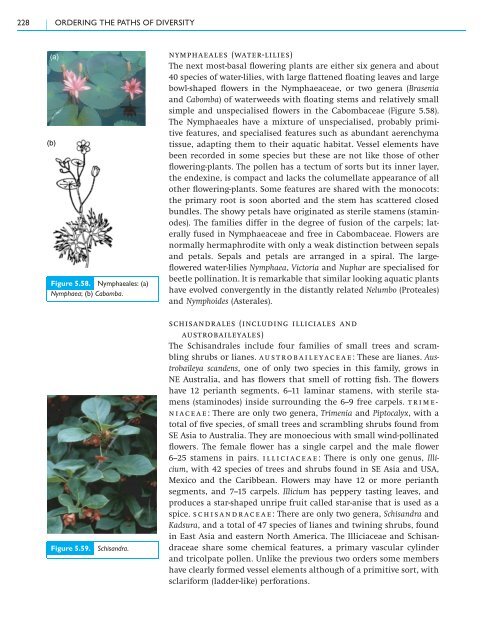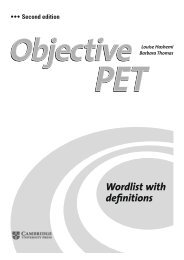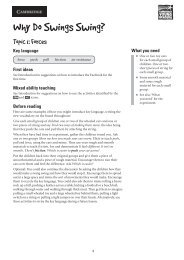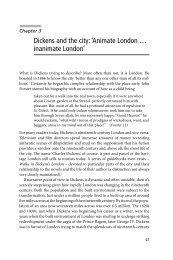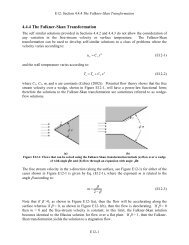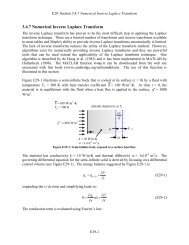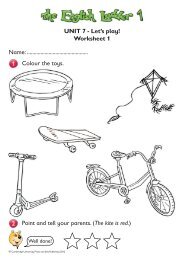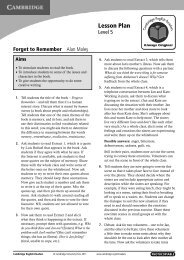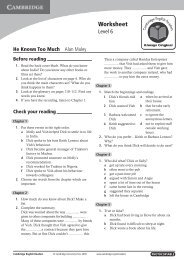5.3 Class Magnoliopsida – flowering plants - Cambridge University ...
5.3 Class Magnoliopsida – flowering plants - Cambridge University ...
5.3 Class Magnoliopsida – flowering plants - Cambridge University ...
Create successful ePaper yourself
Turn your PDF publications into a flip-book with our unique Google optimized e-Paper software.
228 ORDERING THE PATHS OF DIVERSITY<br />
(a)<br />
(b)<br />
Figure 5.58. Nymphaeales: (a)<br />
Nymphaea; (b) Cabomba.<br />
Figure 5.59. Schisandra.<br />
nymphaeales (water-lilies)<br />
The next most-basal <strong>flowering</strong> <strong>plants</strong> are either six genera and about<br />
40 species of water-lilies, with large flattened floating leaves and large<br />
bowl-shaped flowers in the Nymphaeaceae, or two genera (Brasenia<br />
and Cabomba) of waterweeds with floating stems and relatively small<br />
simple and unspecialised flowers in the Cabombaceae (Figure 5.58).<br />
The Nymphaeales have a mixture of unspecialised, probably primitive<br />
features, and specialised features such as abundant aerenchyma<br />
tissue, adapting them to their aquatic habitat. Vessel elements have<br />
been recorded in some species but these are not like those of other<br />
<strong>flowering</strong>-<strong>plants</strong>. The pollen has a tectum of sorts but its inner layer,<br />
the endexine, is compact and lacks the columellate appearance of all<br />
other <strong>flowering</strong>-<strong>plants</strong>. Some features are shared with the monocots:<br />
the primary root is soon aborted and the stem has scattered closed<br />
bundles. The showy petals have originated as sterile stamens (staminodes).<br />
The families differ in the degree of fusion of the carpels; laterally<br />
fused in Nymphaeaceae and free in Cabombaceae. Flowers are<br />
normally hermaphrodite with only a weak distinction between sepals<br />
and petals. Sepals and petals are arranged in a spiral. The largeflowered<br />
water-lilies Nymphaea, Victoria and Nuphar are specialised for<br />
beetle pollination. It is remarkable that similar looking aquatic <strong>plants</strong><br />
have evolved convergently in the distantly related Nelumbo (Proteales)<br />
and Nymphoides (Asterales).<br />
schisandrales (including illiciales and<br />
austrobaileyales)<br />
The Schisandrales include four families of small trees and scrambling<br />
shrubs or lianes. austrobaileyaceae: These are lianes. Austrobaileya<br />
scandens, one of only two species in this family, grows in<br />
NE Australia, and has flowers that smell of rotting fish. The flowers<br />
have 12 perianth segments, 6--11 laminar stamens, with sterile stamens<br />
(staminodes) inside surrounding the 6--9 free carpels. trimeniaceae:<br />
There are only two genera, Trimenia and Piptocalyx, with a<br />
total of five species, of small trees and scrambling shrubs found from<br />
SE Asia to Australia. They are monoecious with small wind-pollinated<br />
flowers. The female flower has a single carpel and the male flower<br />
6--25 stamens in pairs. illiciaceae: There is only one genus, Illicium,<br />
with 42 species of trees and shrubs found in SE Asia and USA,<br />
Mexico and the Caribbean. Flowers may have 12 or more perianth<br />
segments, and 7--15 carpels. Illicium has peppery tasting leaves, and<br />
produces a star-shaped unripe fruit called star-anise that is used as a<br />
spice. schisandraceae: There are only two genera, Schisandra and<br />
Kadsura, and a total of 47 species of lianes and twining shrubs, found<br />
in East Asia and eastern North America. The Illiciaceae and Schisandraceae<br />
share some chemical features, a primary vascular cylinder<br />
and tricolpate pollen. Unlike the previous two orders some members<br />
have clearly formed vessel elements although of a primitive sort, with<br />
sclariform (ladder-like) perforations.


